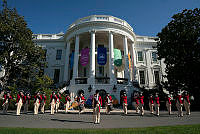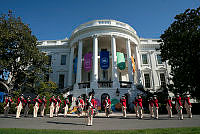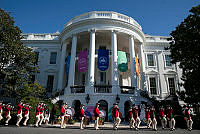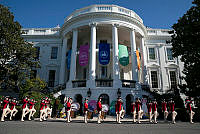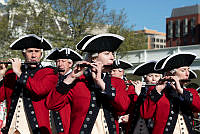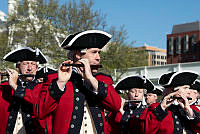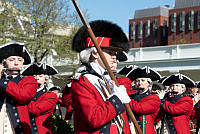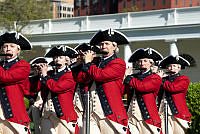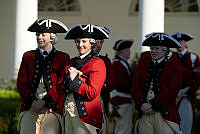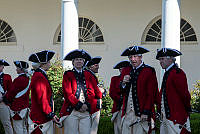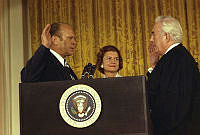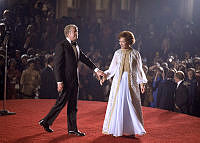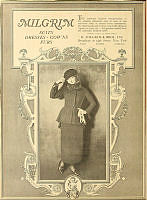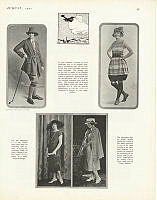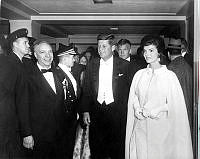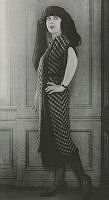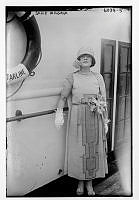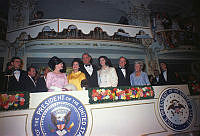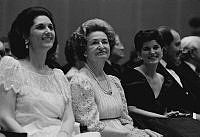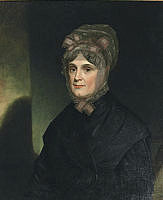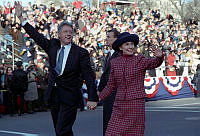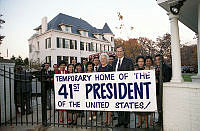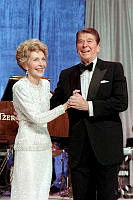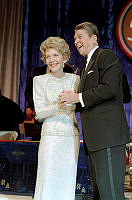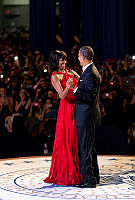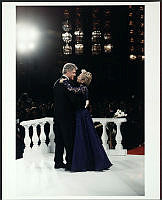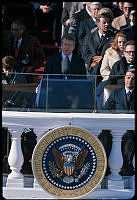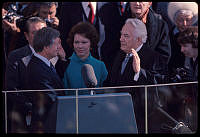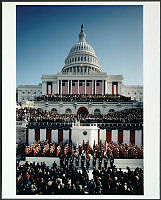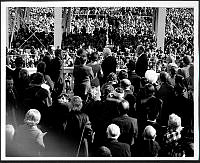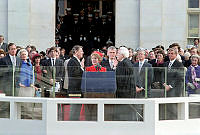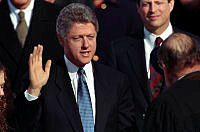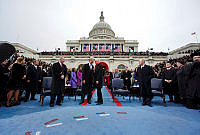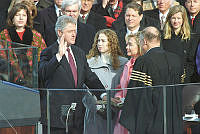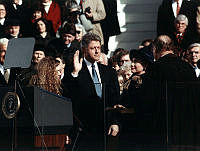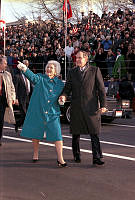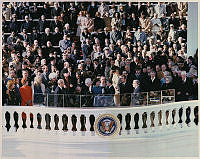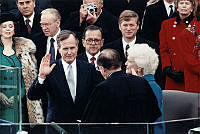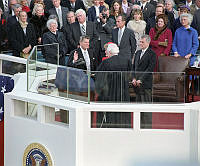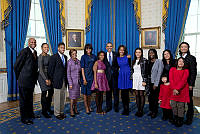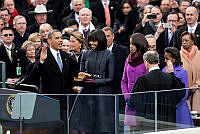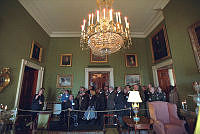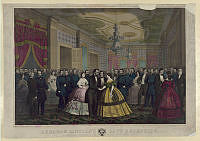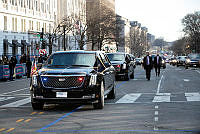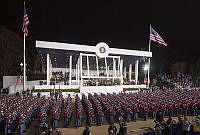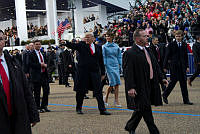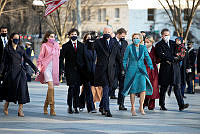Eleanor Roosevelt's "My Day": Household
Copyright © White House Historical Association. All rights reserved under international copyright conventions. No part of this article may be reproduced or utilized in any form or by any means, electronic or mechanical, including photocopying, recording, or by any information storage and retrieval system, without permission in writing from the publisher. Requests for reprint permissions should be addressed to books@whha.org
Eleanor Roosevelt (ER) believed that the White House "staff and the ushers and the housekeeper deserve all the credit that we can give them." The mansion staff, led by housekeeper Henrietta Nesbitt and a succession of chief ushers, numbered about thirty people during the Franklin D. Roosevelt administration.
Nesbitt, a Hyde Park neighbor of the Roosevelts who had worked with ER in the local Hyde Park League of Women Voters chapter, had little experience beyond running a home bakery when she accepted the job. ER, despite family complaints about meal planning, found Nesbitt "a lifesaver" and hired Nesbitt's husband Henry as a White House custodian. Nesbitt worked with three Chief Ushers: Ike Hoover who died in 1933, Raymond Muir who left in 1938 to take a job in the State Department, and Howell Crim who remained until 1957.
At ER's insistence, the White House's domestic staff was African American and included several people who had worked for the Roosevelts before they came to the White House. These latter individuals included ER's maid, Mary Foster, FDR's valet, Irvin (Mac) McDuffie and his wife, Elizabeth (Lizzie) also a maid. Mabel Haley (later Webster), who worked for the family when FDR served as Assistant Secretary of the Navy, joined the mansion staff as ER's personal maid after Mary Foster's death in 1933. Mac, a barber by profession, first met FDR in Warm Springs, Georgia in 1927 and shortly thereafter became his valet. Besides helping FDR bathe and dress, Mac also served as one of FDR's informal confidants. His heavy drinking concerned ER who worried he would leave the president alone at a critical moment. She wanted FDR to fire him, but the president never did. (Mac ultimately left the White House in 1939 after suffering a nervous breakdown due to overwork. Thereafter, a series of valets shared the job, a situation FDR jokingly referred to as "divided custody.") FDR was equally fond of Lizzie, the only staff member allowed to clean his room. A graduate of Morris Brown College in Atlanta, Lizzie possessed keen intelligence and a good sense of humor. She would tease FDR and sometimes entertain him with her ventriloquism skills. Because he felt comfortable with her, Lizzie often went to Hyde Park and Warm Springs with FDR. She was with him on his last trip to Warm Springs in April, 1945 and remembered "the deep, steady long gasps" of his breathing as he lay dying.
Over time Lizzie became much more than a trusted family retainer. She served as a liaison between ER and civil rights activists and campaigned for FDR's re-election in 1936 and 1940. With ER's apparent blessing she also became a leader in the United Government Employees, a union with a special following among lower-paid workers.

Mrs. Henrietta Nesbitt, White House (housekeeper), February 1939.
The McDuffies were not the only White House staff members related to one another. Head maid, Maggie Rogers, and her daughter, Lillian Rogers Parks, a seamstress, worked at the White House as did Chief Butler Alonzo Fields and his brother George, a valet during World War II. (Parks and FDR shared a special bond; both had suffered polio. Whenever he saw her walking with her crutch, Lillian Parks recalled, FDR would ask, "Are you happy . . . Are you being treated all right? We have to stick together, you know." He would also invite her to ride in the White House elevator with him).
Though Lillian Parks, her mother and most of the White House staff lived out, several staff members including the McDuffies and Mabel Haley Webster had rooms on the Third Floor as did some of the unmarried mansion staff. Curtis Roosevelt (“Buzz or Buzzie”), the Roosevelts' oldest grandson who lived on the Third Floor with his older sister Anna Eleanor (“Sisty”) when they stayed at the White House, recalled the staff's "gentility of manner, formal but easy. They would . . . tease and laugh, making ordinary things such as serving our meals . . . into an enjoyable game."
The staff's ease of manner belied the difficulty of their jobs. Just keeping the White House clean required a herculean effort. Every day the mansion staff polished all the floors and vacuumed all the rugs in the house. They also hand-washed, waxed and polished the floor of the kitchen each night. They dusted every room and made sure that the drapes and furniture were cleaned and maintained. Managing the table linens was another time consuming chore. Lillian Parks recalled how she had to count and fold tea napkins "two and three hundred" at a time for ER's many teas. Bigger jobs such as the annual cleaning of the East Room chandeliers required a week of solid effort. The washers first stood atop specially constructed trestles to dust the chandeliers. They then removed the glass prisms, washed and polished them individually and stood on the trestles to re-hang them.
The Roosevelts' constant entertaining posed another challenge for the staff, especially since the number of people per event often fluctuated. A dinner for 30 could at the last minute turn into a dinner for 45; a tea planned for 3,000 might have as many as 1,200 extra guests. Such large scale events necessitated massive amounts of food. A routine event such as the Roosevelts' annual prewar garden party for World War I Veterans required the White House kitchen staff to make 3,200 sandwiches, hand squeeze 2 ½ crates of lemons to make lemonade, and order 72 cakes and untold quantities of ice cream and cookies from outside sources. The menu for the annual White House Press Corps dance included 25 hams, 20 tongues, 10 pounds each of different kinds of cold cuts and 24 pounds of potato chips. World War II reduced the number of social events and simplified the menus but the scale of entertaining remained unchanged. The 2,000 guests at FDR's 1945 inaugural luncheon, for example, consumed a chicken salad made from 200 chickens plus 170 dozen rolls, 165 unfrosted cakes (sugar and butter were rationed) and 90-100 gallons of coffee.
ER's penchant for inviting people to stay at the White House also challenged the staff's flexibility particularly during World War II when the Roosevelts seemed to be running a small hotel for exiled royalties and visiting allied leaders. Lillian Parks recalled the mansion staff waiting anxiously for one guest to leave so they could prepare the room for the next. Sometimes guests "would actually be waiting in the hall while previous guests were still packing," she remembered.
Concerned about the staff's long hours and the White House's inadequate facilities, ER did everything she could to make working conditions as pleasant as possible. In 1935 for example, she had the mansion kitchen remodeled, installing modern appliances and creating a staff dining room from a corner of the old kitchen. She added locker rooms and a small staff lounge as well. ER also involved herself in the staff's personal lives. When the wife of longtime White House doorman John Mays died suddenly, ER made sure members of the White House staff stayed with him at his home until she could get there herself. When the son of her maid, Mabel died, she attended the funeral—a controversial decision in segregated Washington. She also used "My Day" to commend the mansion staff publicly for their hard work. For example, the day after a family birthday party that turned into an impromptu dance and sing along, she visited "the kitchen, the pantry and the flower room to thank everyone who contributed something to making yesterday happy for us all." In January 1937, as the last festivities surrounding FDR's second inauguration ended, she remarked "While I have always admired the spirit with which the work is done in the White House, I don't think it ever came home to me with more force than yesterday." Staff realized that "the dignity of the house . . . is at stake and everyone feels they are serving the country in doing their work well." Two Christmases later, when every generation from little Franklin III to FDR's mother had celebrated the holiday season in the White House, ER praised the staff's ability "to meet all the various demands with apparent ease and no friction."
That ease and lack of friction characterized the White House staff during the Roosevelt years. Whatever the situation, they met it with grace and efficiency up to and including FDR's unexpected death and funeral in April, 1945. Their composure cracked just once—when ER and her family left the White House for the last time. "We all lined up to say good-by to Mrs. Roosevelt . . .," recalled Lillian Parks. "The servants cried and . . . the Roosevelt family [except ER] cried."
As she left the White House, ER acknowledged the staff's devotion, their professionalism and their contribution to the success of the Roosevelt administration. "No one will ever be more grateful than I am to all the various people with whom we have been in contact because we lived in this house . . . who made life not only possible but pleasant and gracious."














